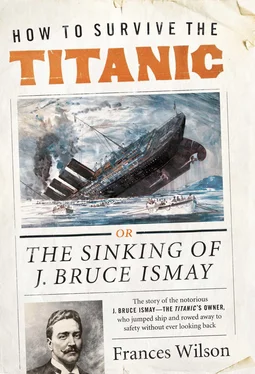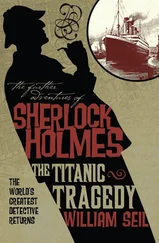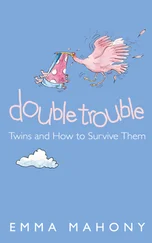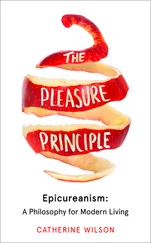In I922, Costelloe Lodge was destroyed in an arson attack by the IRA — these were the years of the War of Independence, when big houses were everywhere going up in flames — but Ismay, undeterred, had it rebuilt brick by brick, taking great interest in the project. The new lodge was designed by Sir Edwin Lutyens and the garden laid out by Gertrude Jekyll. In I927, Ismay’s second daughter, Evelyn, married Harold Sanderson’s son, Basil, uniting the two families in a way that would have pleased Thomas Ismay. Evelyn later completed the convergence of the twain by giving birth to Ismay-Sanderson twins.
Evelyn’s daughter, Pauline Matarasso, remembers the ‘solemnity’ of her grandparents’ Hill Street home. ‘Anyone arriving at the house was met by a triumvirate: two footmen, one as dark as the other was fair, would be standing on the steps to either side of the door, flanking the heavier figure of the butler, poised to take the name of the visitor.’ She does not recall Ismay speaking, ‘though I suppose he must have given us some form of greeting.’ 5Adding to the austerity of the atmosphere was the silence around the subject of the Titanic. To the horror of the dinner table, one child once asked his grandfather whether he had ever been in a shipwreck, while another, proud to be able to impart such adult information, told Ismay that he had read in the newspapers about a train crash in which 256 people had died. ‘How do you know 256 people died?’ Ismay retorted. ‘Were you there? Did you count them?’ It was not until Ismay’s grandchildren were older that they would hear the story of the Titanic and learn that it was never to be mentioned. ‘Truth’, as Pauline Matarasso puts it, ‘was of little interest to the grown-ups gathered round my childhood. They were in the possession of the facts, which cleared my grandfather of wrongdoing. This concentration on the facts was very calming. Without a moral dimension, without words like hubris, competition, guilt, greed, hedonism, the event was drained of emotion like a stuck pig of blood. It was their way of surviving; they could cope with a corpse. My grandfather Ismay was a corpse himself.’ 6
Ismay spent his last summer in Ireland in 1936, after which acute pains in his right leg led to an amputation below the knee, which took place in his bedroom in Hill Street. Now housebound in London and no longer able to enjoy his outdoor pursuits, he withdrew further into himself. On 27 May of the same year, Cunard White Star’s first ship, the Queen Mary, left Southampton on her maiden voyage — ‘Say,’ quipped an American passenger as she boarded the liner, ‘when does this place reach New York?’ — and on 20 September 1937 the Titanic ’s twin, the Olympic, was taken to Inverkeithing in Scotland to be dismantled. Three weeks later, Ismay suffered a stroke which left him unable to speak or see. He died aged seventy-four on 17 October 1937, the year of George VI’s coronation. Following his funeral at St Paul’s in Knightsbridge, Ismay was cremated and his ashes placed in a shady plot at Putney Vale Cemetery in south London. The four sides of his tomb were engraved by Alfred Gerrard, Head of Sculpture at the Slade School of Fine Art, with a handsome fleet of sailing ships. The stone contains lines from James 3:4:
Behold also the ships which though they be so great and are driven of fierce winds yet are turned about with a very small helm whithersoever the governor listeth.
In the garden of Costelloe Lodge, Florence had the following words carved into a stone:
In memory of Bruce Ismay, who spent many happy hours here 1913–36. He loved all wild and solitary places, where we taste the pleasure of believing that what we see is boundless as we wish our souls to be.
After the inquiry into the case of the Patna finds Jim guilty of ‘abandoning in the moment of danger the lives and property ‘confided to’ his ‘charge’, he is stripped of his seaman’s papers. He stays on in the eastern seaports, limping from job to job like a bird with a broken wing, hiding his identity, unable to endure reference to the scandal, and disappearing whenever it is mentioned. It is impossible, he realises, to lay the ghost of a fact; ‘there is always that bally thing at the back of my head.’ Jim wants a ‘clean slate’ and with Marlow’s help he makes ‘the second desperate leap of his life’, into Patusan, a remote island backwater in the South Seas consisting of bandits, maidens, and thirty miles of forest and surf. In the novel’s second half, Jim is treated as a leader and called by the natives ‘ Tuan or ‘Lord’ Jim. Just as he once gazed at the serenity of the world from the security of the Patna, he now looks ‘with an owner’s eye at the peace of the evening, at the river, at the houses, at the everlasting life of the forests, at the life of the old mankind, at the secrets of the land’. Defending his village from attack by an English marauder, Jim dies like a medieval knight.
‘The division of the book into two parts’, Conrad admitted, was its ‘plague spot’. 7Readers and critics have agreed; Lord Jim is less a book divided into two than a self-divided book, a book which breaks in the middle and, like Wuthering Heights and David Copperfield, it has become a novel remembered for its first part alone. Conrad was successfully able to imagine Jim’s failure but he failed to imagine his success; when his account of Jim’s life in Patusan begins, Marlow relaxes his grip on the young man’s consciousness and the narrative loses its psychological tautness. Conrad would have been wiser to say goodbye to Jim as he embarked on his island life, as he said goodbye to Leggatt in ‘The Secret Sharer’ when he slipped off the ship to swim to Koh-ring, a ‘free man… striking out for his new destiny’. But he was too involved in Jim’s story, he needed too badly see Jim wrest control of his fate, and in order for Jim to win back his honour Conrad had to change the genre of his book. What Albert Guerard described as ‘perhaps the first major novel built on a true intuitive understanding of sympathetic identification as a psychic process’, now became a boy’s adventure story of the kind that Jim had always dreamt of inhabiting.
Jim eventually dies for honour, but has he redeemed himself? Has he, in his island life, faced or shirked his crime? While Conrad made Jim’s ending too easy, Marlow is always drawn to the equivocal and it is the absence of clarity in the young man’s situation that interests him. Despite Marlow’s endless production of words, Jim becomes less and less clear as the tale progresses. It is only, Marlow realises, ‘when we try to grapple with another man’s intimate need that we perceive how incomprehensible, wavering and misty are the beings that share with us the sight of the stars and the warmth of the sun’. By the close of Lord Jim, the book’s subject is no longer the encounter between the self we believe ourselves to be and the self unknown, lying in wait like a snake beneath a stone. Marlow now wonders whether atonement is possible at all, whether a slate can ever be clean. ‘A clean slate, did he say? As if the initial word of each our destiny were not graven in imperishable characters upon the face of a rock.’
The second half of lives, as well as novels, can also be of limited interest. Few people much mind what Wordsworth had to say after he married, and the story of Florence Nightingale ends once she extinguishes her lamp, her final forty years being consigned to a footnote. Conrad used the half of his life spent on land to translate into romance the monotony of the half he spent at sea, and what is curious about Ismay’s life is that having jumped from the Titanic into Conrad’s world, a place in which we live out our time as convicts, self-deceived and unpitied, his story was quickly given a Conradian second half. Ismay was imagined as an outcast on an island even as he attended to his daily rhythm, walking the streets of London in a suit with a rolled umbrella, taking the train to Liverpool, feeding the pigeons in the park. The man whose speech was once described by the press as a ‘luminous fog’ was now constructed by them as a man in a mist. And that, it was assumed of Ismay, is the end. He passes away under a cloud, inscrutable at heart, forgotten, unforgiven, and excessively romantic.
Читать дальше












